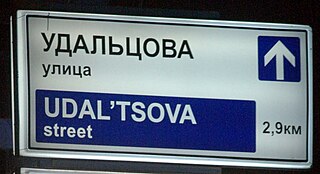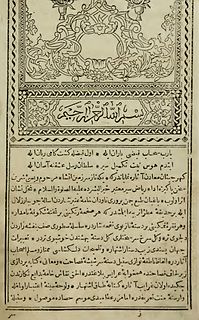Transliteration is a type of conversion of a text from one script to another that involves swapping letters in predictable ways.

Romanization or romanisation, in linguistics, is the conversion of writing from a different writing system to the Roman (Latin) script, or a system for doing so. Methods of romanization include transliteration, for representing written text, and transcription, for representing the spoken word, and combinations of both. Transcription methods can be subdivided into phonemic transcription, which records the phonemes or units of semantic meaning in speech, and more strict phonetic transcription, which records speech sounds with precision.
In digital typography, the TrueType font Arial Unicode MS is an extended version of the font Arial. Compared to Arial, it includes higher line height, omits kerning pairs and adds enough glyphs to cover a large subset of Unicode 2.1—thus supporting most Microsoft code pages, but also requiring much more storage space. It also adds Ideographic layout tables, but unlike Arial, it mandates no smoothing in the 14–18 point range, and contains Roman (upright) glyphs only; there is no oblique (italic) version. Arial Unicode MS is normally distributed with Microsoft Office, but it is also bundled with Mac OS X v10.5 and later. It may also be purchased separately from Ascender Corporation, who licenses the font from Microsoft.

Romanization of Russian is the process of transliterating the Russian language from the Cyrillic script into the Latin script.
MARCstandards are a set of digital formats for the description of items catalogued by libraries, such as books. Working with the Library of Congress, American computer scientist Henriette Avram developed MARC in the 1960s to create records that could be read by computers and shared among libraries. By 1971, MARC formats had become the US national standard for dissemination of bibliographic data. Two years later, they became the international standard. There are several versions of MARC in use around the world, the most predominant being MARC 21, created in 1999 as a result of the harmonization of U.S. and Canadian MARC formats, and UNIMARC, widely used in Europe. The MARC 21 family of standards now includes formats for authority records, holdings records, classification schedules, and community information, in addition to the format for bibliographic records.
ISO 15919 "Transliteration of Devanagari and related Indic scripts into Latin characters" is one of a series of international standards for romanization by the International Organization for Standardization. It was published in 2001 and uses diacritics to map the much larger set of consonants and vowels in Brahmic scripts to the Latin script.
The romanization or Latinization of Ukrainian is the representation of the Ukrainian language using Latin letters. Ukrainian is natively written in its own Ukrainian alphabet, which is based on the Cyrillic script. Romanization may be employed to represent Ukrainian text or pronunciation for non-Ukrainian readers, on computer systems that cannot reproduce Cyrillic characters, or for typists who are not familiar with the Ukrainian keyboard layout. Methods of romanization include transliteration, representing written text, and transcription, representing the spoken word.
ALA-LC is a set of standards for romanization, the representation of text in other writing systems using the Latin script.
The Library of Congress Control Number (LCCN) is a serially-based system of numbering cataloging records in the Library of Congress in the United States. It has nothing to do with the contents of any book, and should not be confused with Library of Congress Classification.
The international standard ISO 233 establishes a system for Arabic and Syriac transliteration (Romanization). It has been supplemented by ISO 233-2 in 1993.
Romanization of Greek is the transliteration (letter-mapping) or transcription (sound-mapping) of text from the Greek alphabet into the Latin alphabet. The conventions for writing and romanizing Ancient Greek and Modern Greek differ markedly, which can create confusion. The sound of the English letter B was written as β in ancient Greek but is now written as the digraph μπ, while the modern β sounds like the English letter V instead. The Greek name Ἰωάννης became Johannes in Latin and then John in English, but in Greek itself has instead become Γιάννης; this might be written as Yannis, Jani, Ioannis, Yiannis, or Giannis, but not Giannes or Giannēs as it would have been in ancient Greek. The masculine Greek word Ἅγιος or Άγιος might variously appear as Hagiοs, Agios, Aghios, or Ayios, or simply be translated as "Holy" or "Saint" in English forms of Greek placenames.
The romanization of Arabic writes written and spoken Arabic in the Latin script in one of various systematic ways. Romanized Arabic is used for a number of different purposes, among them transcription of names and titles, cataloging Arabic language works, language education when used in lieu of or alongside the Arabic script, and representation of the language in scientific publications by linguists. These formal systems, which often make use of diacritics and non-standard Latin characters and are used in academic settings or for the benefit of non-speakers, contrast with informal means of written communication used by speakers such as the Latin-based Arabic chat alphabet.
The Research Libraries Group (RLG) was a U.S.-based library consortium that existed from 1974 until its merger with the OCLC library consortium in 2006. RLG developed the Eureka interlibrary search engine, the RedLightGreen database of bibliographic descriptions, and ArchiveGrid, a database containing descriptions of archival collections. It also developed a framework known as the "RLG Conspectus" for evaluating research library collections, which evolved into a set of descriptors used in library collection policy statements, last updated in 1997. The Library of Congress used the conspectus in 2015 in the revision of its own collection policy statement, and decided to retain this resource on its website, as a helpful scale for judging an academic collection's depth.

In library and information science, cataloging is the process of creating metadata representing information resources, such as books, sound recordings, moving images, etc. Cataloging provides information such as creator names, titles, and subject terms that describe resources, typically through the creation of bibliographic records. The records serve as surrogates for the stored information resources. Since the 1970s these metadata are in machine-readable form and are indexed by information retrieval tools, such as bibliographic databases or search engines. While typically the cataloging process results in the production of library catalogs, it also produces other types of discovery tools for documents and collections.
The ALA-LC Romanization tables for Slavic alphabets is a set of standards for romanization of texts in various writing systems used in North American libraries and publications. The latest version was published by the American Library Association and the Library of Congress in 1997. This article is about the ALA-LC method of transliteration of Russian-language text from Cyrillic script to Latin script.

The Ottoman Turkish alphabet is a version of the Perso-Arabic alphabet used to write Ottoman Turkish until 1928, when it was replaced by the Latin-based modern Turkish alphabet.

Henriette Davidson Avram was a computer programmer and systems analyst who developed the MARC format, the international data standard for bibliographic and holdings information in libraries. Avram's development of the MARC format in the late 1960s and early 1970s at the Library of Congress had a revolutionizing effect on the practice of librarianship, making possible the automation of many library functions and the sharing of bibliographic information electronically between libraries using pre-existing cataloging standards.
Romanization of Persian or Latinization of Persian is the representation of the Persian language with the Latin script. Several different romanization schemes exist, each with its own set of rules driven by its own set of ideological goals.
Resource Description and Access (RDA) is a standard for descriptive cataloging initially released in June 2010, providing instructions and guidelines on formulating bibliographic data. Intended for use by libraries and other cultural organizations such as museums and archives, RDA is the successor to Anglo-American Cataloguing Rules, Second Edition (AACR2).
The MARC-8 charset is a MARC standard used in MARC-21 library records. The MARC formats are standards for the representation and communication of bibliographic and related information in machine-readable form, and they are frequently used in library database systems. The character encoding now known as MARC-8 was introduced in 1968 as part of the MARC format. Originally based on the Latin alphabet, from 1979 to 1983 the JACKPHY initiative expanded the repertoire to include Japanese, Arabic, Chinese, and Hebrew characters, with the later addition of Cyrillic and Greek scripts. If a character is not representable in MARC-8 of a MARC-21 record, then UTF-8 must be used instead. UTF-8 has support for many more characters than MARC-8, which is rarely used outside library data.






